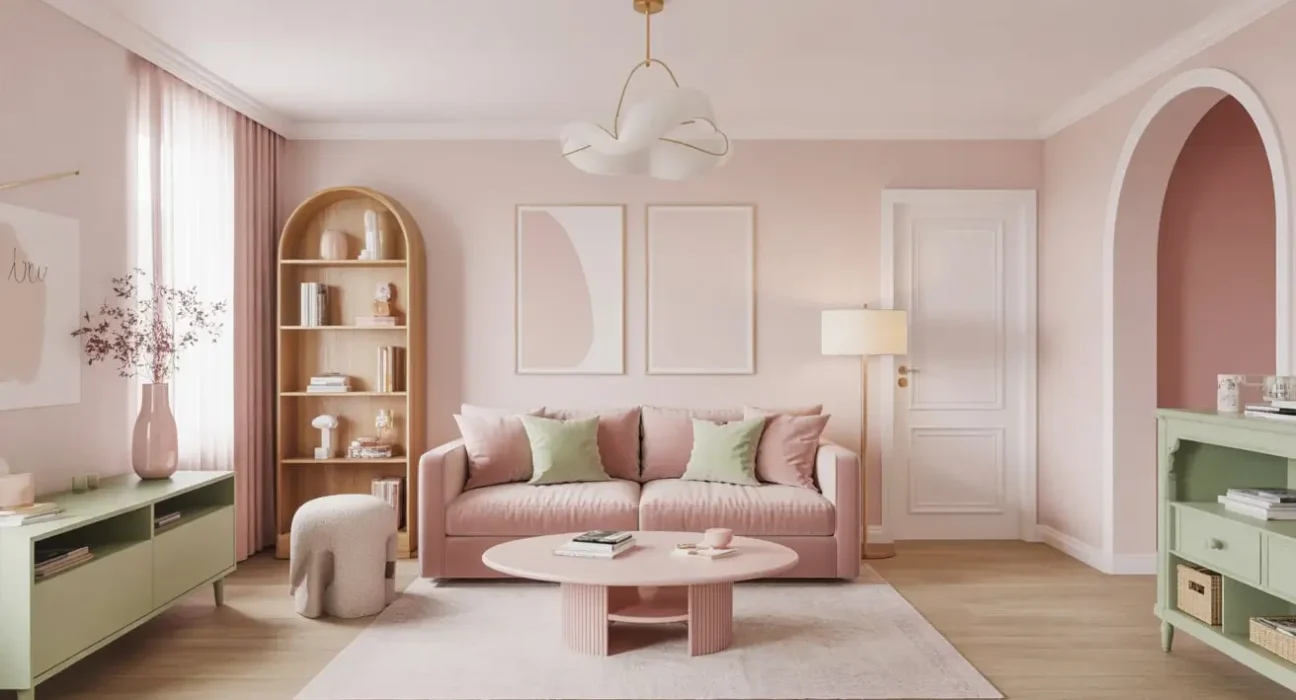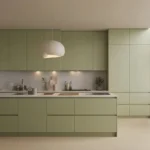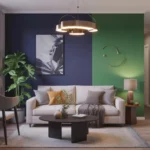You know that feeling when you walk into someone’s living room and immediately want to kick off your shoes, grab a blanket, and settle in for hours? Yeah, that’s the magic we’re chasing here. Your living room shouldn’t feel like a furniture showroom where you’re afraid to sit down—it should wrap around you like your favorite oversized sweater on a Sunday morning.
I’ve spent way too many evenings scrolling through design photos, sitting in uncomfortably styled rooms, and finally figuring out what actually makes a space feel warm and inviting. Spoiler alert: it’s not about dumping money into expensive furniture. It’s about creating layers, textures, and that intangible “come sit with me” vibe that makes your space feel like home.
Let me walk you through 15 living room decor ideas that’ll transform your space from “meh” to “wow, can I move in?” Each one brings its own flavor of cozy, so whether you’re Team Minimalist or Team Maximalist, there’s something here that’ll speak to you.
Modern Boho Living Room Vibes
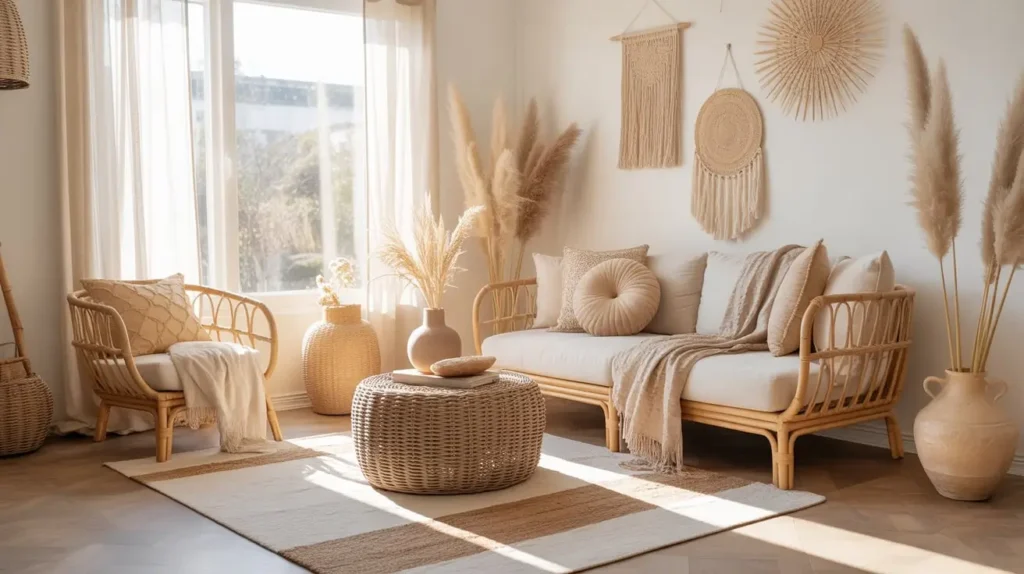
Let’s kick things off with the style that refuses to follow rules—and honestly, I love it for that. Modern boho mixes patterns, textures, and cultural influences like a design rebel who somehow makes everything work together.
The secret sauce? Layering without overthinking. Start with a neutral base (think cream or taupe walls) and then pile on the personality. I’m talking macramé wall hangings, woven baskets, and those gorgeous Moroccan-style poufs that double as extra seating when your friends inevitably crash your space.
Throw pillows are your best friend here—mix geometric prints with tribal patterns and solid textures. Don’t match them perfectly; that’s literally the opposite of what we’re going for. Add some hanging plants (pothos are impossible to kill, FYI), a vintage rug with actual character, and maybe a rattan chair that looks like it has stories to tell.
The whole vibe should feel collected over time, not bought in one Target run. Layer different wood tones, add brass accents, and remember: more is more in boho land, but keep it intentional, not chaotic.
Cozy Minimalist Neutrals
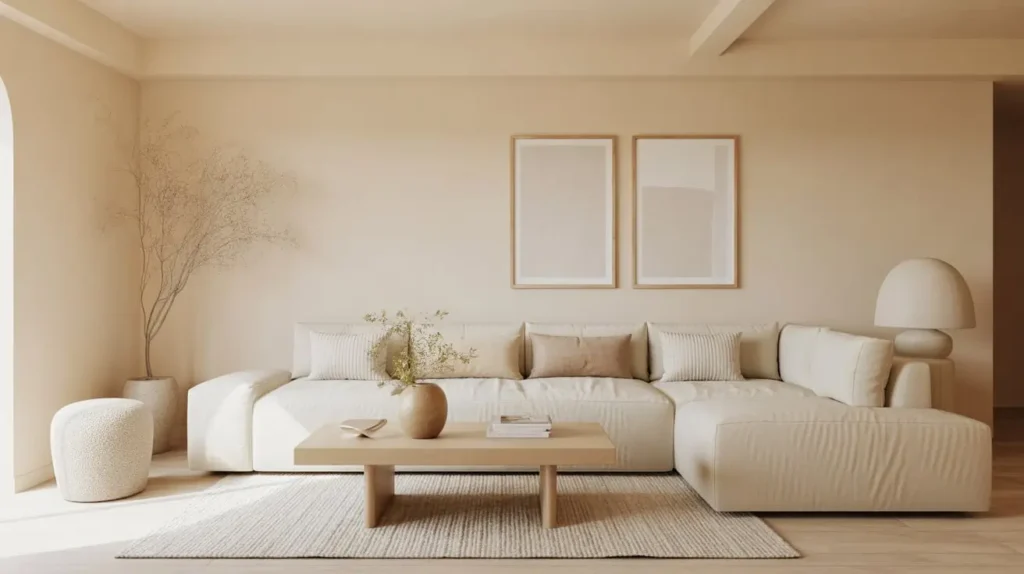
Now, if the boho approach makes you twitch, let’s talk about the zen master of cozy—minimalist neutrals. This style proves you don’t need clutter to create warmth, and honestly? That’s pretty impressive.
Picture this: a palette of warm whites, soft beiges, and gentle taupes that flow together like a really good latte. The trick isn’t about having less stuff (though that helps)—it’s about choosing pieces that earn their keep. Every item should either serve a function or bring you genuine joy.
Your sofa becomes the star here. Go for something with clean lines but sink-into-me cushions—comfort and style aren’t enemies. Add texture through materials: a chunky knit throw, linen curtains that puddle slightly on the floor, a wool rug with subtle pattern variation.
Keep surfaces mostly clear, but add warmth with natural elements—a simple vase with dried pampas grass, a wooden coffee table with visible grain, ceramic pieces in matte finishes. The beauty lives in the details: soft lighting from table lamps, maybe a single piece of meaningful art, and the breathing room that lets your brain actually relax.
This style isn’t cold minimalism—it’s warm minimalism, and there’s a huge difference.
Scandinavian-Inspired Comfort
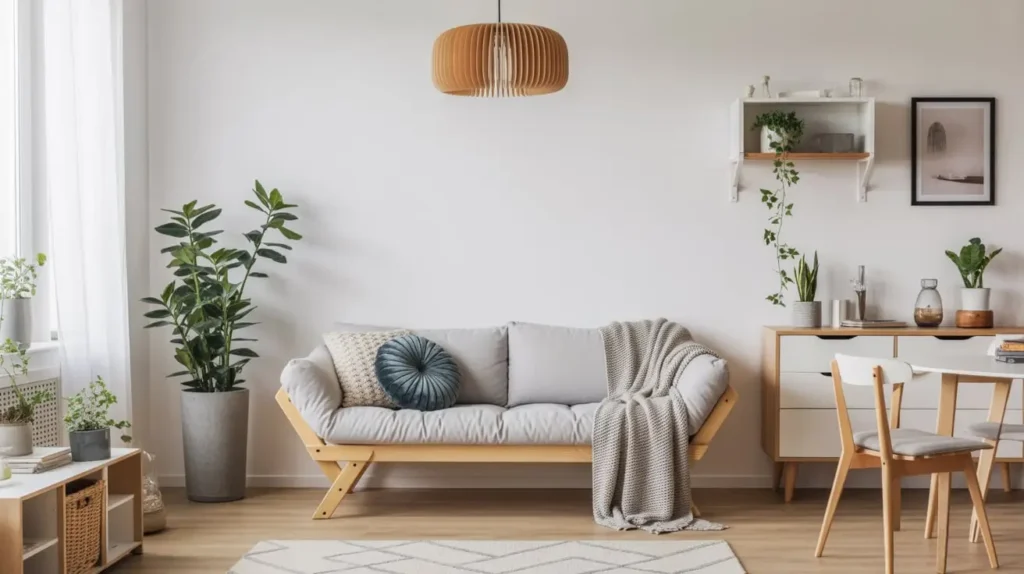
The Scandinavians figured something out during those long, dark winters: your living room needs to fight seasonal depression with everything it’s got. Enter hygge (pronounced “hoo-ga,” you’re welcome) and the Scandi aesthetic that masters cozy like nobody’s business.
Start with light wood furniture—birch, ash, or light oak that practically glows in any lighting. Pair it with whites and grays, but not the cold kind. We’re talking warm grays and off-whites that feel soft, not sterile.
Lighting is crucial here. You need multiple light sources at different heights—floor lamps, table lamps, maybe some string lights if you’re feeling it. Scandinavian winters are dark, so they’ve mastered the art of ambient lighting that makes you want to curl up with a good book.
Add texture through textiles: sheepskin throws draped over chairs, chunky cable-knit pillows, linen everything. Plants bring life to the space—fiddle leaf figs, rubber plants, or simple eucalyptus stems in clear glass vases.
The furniture should be functional but beautiful, with clean lines that don’t scream for attention. Think comfortable seating, smart storage solutions, and that perfect balance between form and function that makes you wonder why everyone doesn’t design this way.
Earthy Tones and Natural Textures

Ever walk outside after rain and just breathe in that earthy smell? That’s the energy we’re bottling up for this living room style. Earthy tones root your space in nature, creating a grounded, organic atmosphere that feels instinctively comfortable.
Build your palette around terracotta, sage green, warm browns, and clay colors. These aren’t trendy colors that’ll make you cringe in three years—they’re timeless because they literally come from the earth. Smart, right?
Natural textures do the heavy lifting here. Rattan furniture, jute rugs, linen upholstery, raw wood coffee tables—basically anything that makes you think “yeah, that grew somewhere.” Layer different textures to create depth: smooth ceramic against rough woven baskets, sleek leather against nubby wool.
Bring the outside in with live plants (not those sad fake ones that fool absolutely nobody). Large-leafed plants like monstera or bird of paradise create dramatic focal points, while smaller plants on shelves add life throughout the space.
Stone and clay accessories—think pottery, pebbles, wooden bowls—complete the look. The whole space should feel like a breath of fresh air, even when you’re three floors up in a city apartment.
Also Read: 15 Dreamy Green Kitchen Ideas for a Modern Makeover
Vintage Glam Living Space
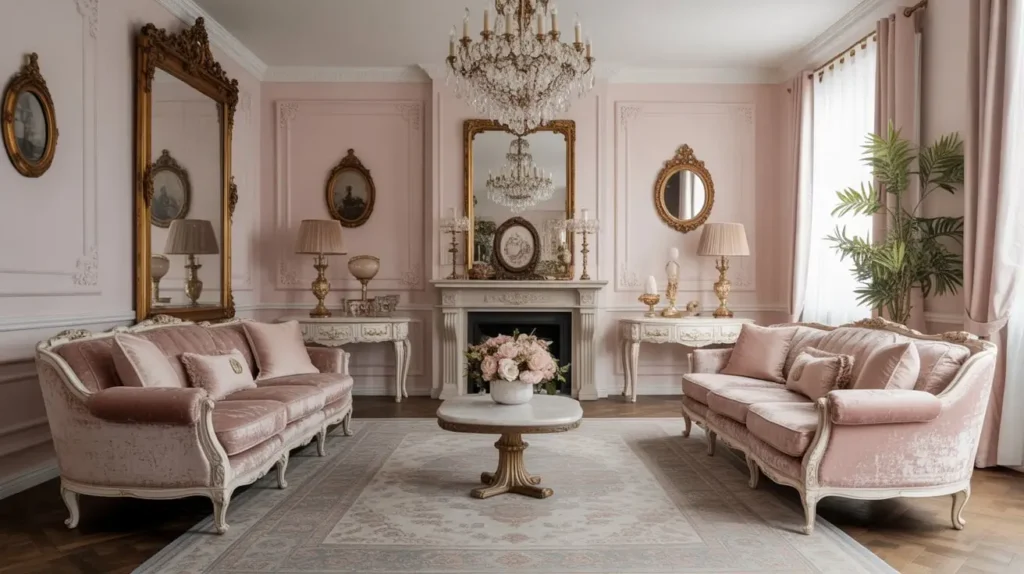
Okay, confession time: I have a serious weakness for vintage glam. There’s something about mixing old Hollywood elegance with livable comfort that just hits different.
Velvet is your MVP here—a jewel-toned velvet sofa in emerald, sapphire, or ruby becomes an instant statement piece. Pair it with brass or gold accents in light fixtures, side tables, and picture frames. The metal should have a slightly aged patina, not that shiny new brass that looks like it’s trying too hard.
Layer in vintage finds: an art deco mirror, a mid-century credenza, a tufted ottoman that looks like it survived a few decades of cocktail parties. These pieces bring character and history that new furniture simply can’t match.
Don’t forget the lighting—a sculptural floor lamp or a vintage-inspired chandelier adds drama. Crystal or glass elements catch light beautifully, creating sparkle without looking like a disco ball threw up in your living room.
The trick is balancing glamorous with livable. Yes to the fancy velvet sofa, but also yes to throws and pillows that invite you to actually sit on it. You want “elegant but not a museum” vibes—a place where you can sip wine and feel fancy, but also binge Netflix in your pajamas without guilt.
Japandi Serenity Style
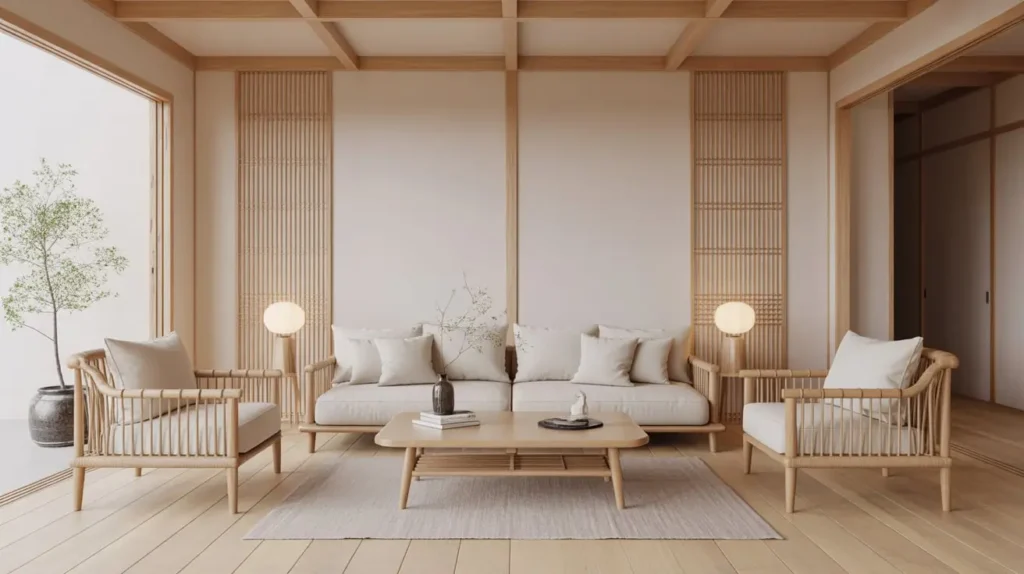
When Japanese minimalism meets Scandinavian coziness, you get Japandi—arguably one of the most peaceful design styles your living room could ask for. IMO, this style is perfect for people who crave calm spaces but still want warmth.
The color palette stays quiet and neutral: blacks, whites, beiges, and soft grays create a serene backdrop. But here’s where it differs from stark minimalism—you incorporate natural wood tones and organic shapes that add warmth without noise.
Furniture sits low to the ground with clean, simple lines. Think Japanese-inspired coffee tables, low-profile sofas, and floor cushions that invite casual lounging. Every piece should be both beautiful and functional—no decoration for decoration’s sake.
Negative space becomes as important as the furniture itself. Don’t fill every corner; let the room breathe. This emptiness isn’t cold—it’s intentional calm, a visual pause that lets your mind rest.
Add life through carefully chosen plants, handmade ceramics, and textiles in natural fibers. A single piece of meaningful art beats a gallery wall here. The goal? A space so peaceful that stress literally can’t survive in it.
Quality over quantity rules everything. Save up for that handcrafted wooden bench rather than buying cheap furniture that’ll fall apart. Japandi celebrates craftsmanship and the beauty of natural materials aging gracefully.
Bold Color Pop Accents
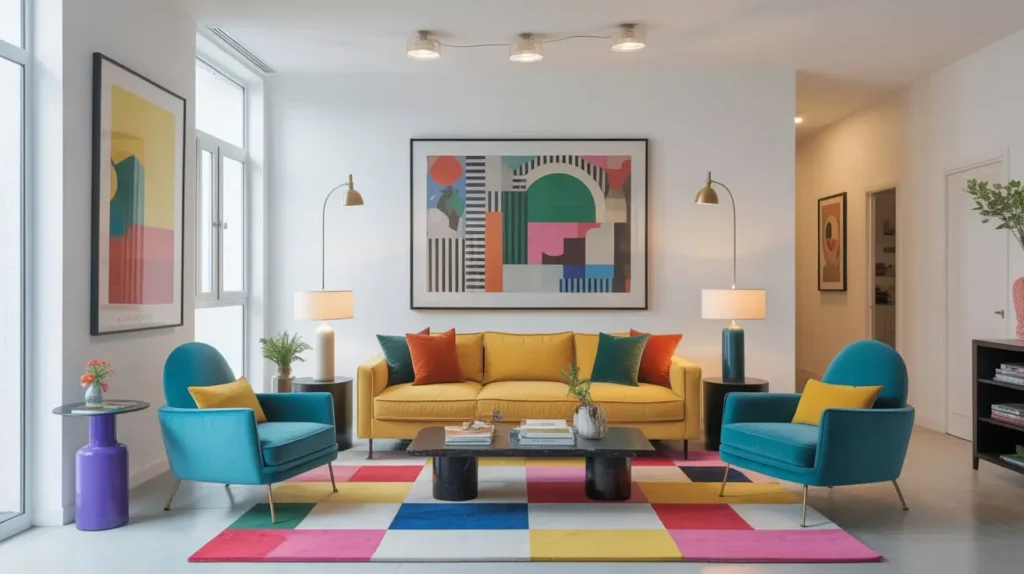
Listen, neutral doesn’t have to mean boring, but sometimes you just want to kick beige in the teeth and make a statement. Color pop accents let you have your calm base cake and eat your vibrant frosting too.
Start with a neutral foundation—white, gray, or beige walls and larger furniture pieces. This gives you flexibility and keeps the space from overwhelming your eyeballs. Then comes the fun part: strategic color explosions.
Choose one or two bold accent colors—maybe a deep mustard yellow and a vibrant teal. Use them in pillows, throws, artwork, or even a single accent chair that makes people go “whoa.” The key is repetition: use your chosen colors in at least three different spots so the look feels intentional, not random.
A colorful area rug can anchor the entire room while introducing multiple accent shades. Artwork becomes both decoration and color source—let your wall art inform your accent choices, or vice versa.
Switch out pillows seasonally if you’re into that kind of commitment. Bright corals and yellows for summer? Sure. Deep burgundies and forest greens for fall? Absolutely. The neutral base means you can play with color without repainting or replacing furniture.
Want to go bolder? Paint one accent wall in a saturated color, or add colorful curtains that frame your windows like artwork. Just remember: bold doesn’t mean chaotic. Keep it cohesive, and you’ll nail that perfect balance between exciting and exhausting.
Rustic Farmhouse Charm
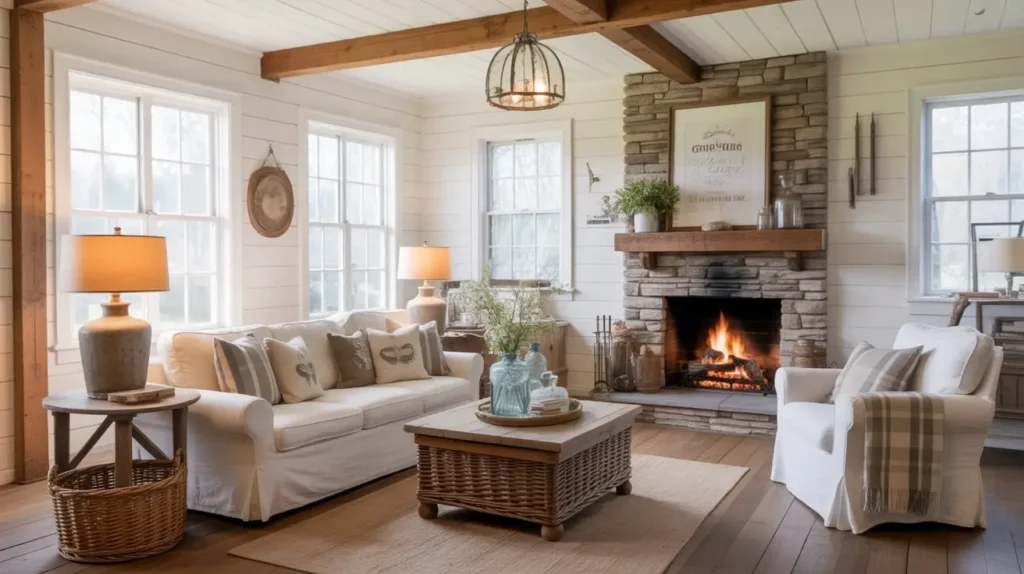
You know that farmhouse aesthetic that Pinterest basically built its empire on? Yeah, it’s popular for a reason—it makes you feel like you’re wrapped in a warm hug from your favorite grandparent, even if you live in a studio apartment downtown.
Reclaimed wood becomes your best friend here. Coffee tables from old barn doors, floating shelves from salvaged lumber, exposed beams if you’re lucky enough to have them. The imperfections tell stories—knots, nail holes, weathered patina—all character marks that new wood can’t fake.
Pair the wood with soft, neutral fabrics: white linen, cream cotton, maybe some gingham or buffalo check if you’re feeling classic. The contrast between rough wood and soft textiles creates that perfect farmhouse tension.
Vintage and antique finds make this style sing. An old ladder as a blanket holder, mason jars (yeah, really) as vases, metal milk cans as umbrella stands. Hit up flea markets and estate sales—you’re looking for pieces with history and patina, not reproductions from chain stores.
Keep the palette warm and welcoming: whites, creams, soft grays, with touches of black for contrast. Add greenery through fresh or dried flowers—lavender bundles, cotton stems, eucalyptus—in simple containers.
The whole vibe should feel lived-in and loved, not styled within an inch of its life. This is comfort food in interior design form—familiar, warm, and exactly what you need after a rough day.
Luxe Modern Marble Touches
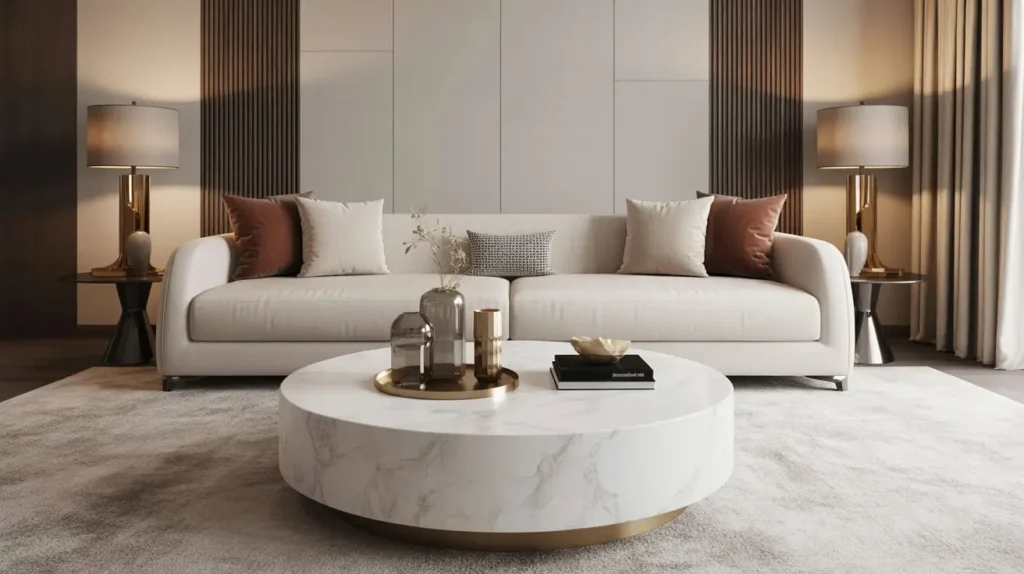
Want to add some grown-up sophistication without looking like you’re trying too hard? Marble accents bring instant luxury while keeping things modern and clean.
I’m not suggesting you marble everything (please don’t)—strategic touches go way further. A marble coffee table becomes a stunning focal point, or smaller marble side tables add elegance without overwhelming. Marble trays, coasters, and bookends bring the look without the commitment or price tag.
The beauty of marble lies in its natural variation—no two pieces look identical. White Carrara marble offers classic elegance with gray veining, while black or green marble adds drama. The stone catches light beautifully and feels cool and substantial in a really satisfying way.
Pair marble with rich materials: velvet upholstery, brass fixtures, dark woods. The combination screams luxury but in a whispered, confident way—not shouty and desperate for attention.
Keep the space uncluttered so your marble pieces can shine. This isn’t the style for shabby chic or cluttered maximalism. Clean lines, quality over quantity, and careful curation make marble accents work.
One warning though: real marble stains and etches, especially with acidic stuff like wine or lemon. Coasters aren’t optional—they’re survival gear :/ Sealed marble helps, but you’re still working with natural stone that requires respect.
Also Read: 15 Dreamy Sage Green Kitchen Ideas for a Cozy Home
Urban Industrial Chic

Exposed brick, metal fixtures, and that “converted warehouse” vibe—industrial style brings edgy coolness to your living room without feeling cold or uninviting.
Start with the raw architectural elements: exposed brick walls, concrete floors or concrete-look tile, visible ductwork or pipes if you’ve got them. Don’t cover up those “flaws”—they’re literally your foundation here.
Metal plays a starring role: steel-framed windows, iron shelving units, metal coffee tables with rivets and welds showing. Mix different metal finishes—brushed steel with aged iron, copper with black metal—for depth and interest.
Balance the hardness with soft textures: leather sofas that’ll age beautifully, chunky knit throws, plush area rugs. You want industrial, not interrogation room. The contrast between tough materials and cozy textiles creates that perfect livable edge.
Oversized vintage pieces fit perfectly here: old factory carts as coffee tables, metal lockers for storage, vintage industrial lighting fixtures. Scour architectural salvage yards and industrial surplus stores for authentic pieces with real history.
The color palette typically stays neutral with pops of raw material colors: grays, blacks, browns, with the warm tones of brick and wood, plus metallic sheens. Add life through green plants—the organic contrast against all that metal and concrete just works.
Coastal Breeze Living Room

Close your eyes and imagine the beach. Now open them, because we’re bringing that breezy, relaxed coastal energy into your living room, even if you’re landlocked in the middle of nowhere.
The palette centers on blues, whites, and sandy neutrals—think ocean, clouds, and beach. But skip the theme-park obvious stuff (no anchor pillows unless you want your room to look like a nautical gift shop).
Light, natural fabrics keep things airy: white or cream linen curtains that blow in the breeze, cotton slipcovers that you can actually wash, jute or sisal rugs that bring that beachy texture. Everything should feel relaxed and unfussy.
Bring in coastal elements through natural materials: driftwood as decor, rope details in subtle ways, glass vessels that remind you of sea glass. A large mirror reflects light and makes the space feel bigger and brighter—key coastal moves.
Weathered wood furniture in whitewashed or light natural finishes keeps the look casual. You want pieces that look like they’ve been beach-side for years, soaking up salt air and sunshine.
Add touches of organic texture: woven baskets, ceramic vases, linen pillows. Plants like palms or ferns bring life without cluttering the breezy aesthetic. The whole space should feel like you can kick back, breathe deeply, and decompress—basically, vacation mode activated.
Moody Dark Aesthetic
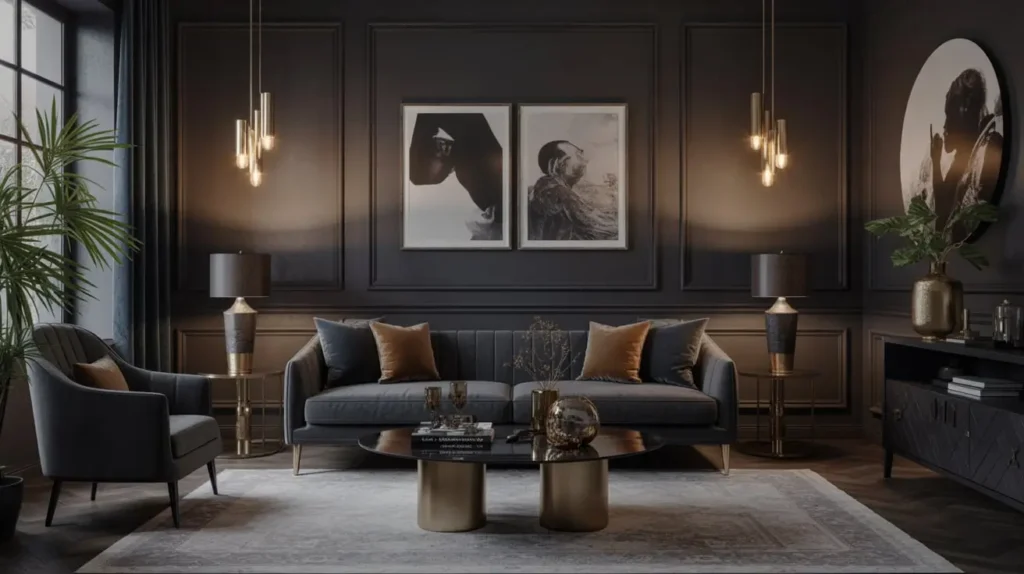
Hot take: dark living rooms can feel incredibly cozy, maybe even cozier than bright ones. When done right, moody dark aesthetics wrap around you like a warm, sophisticated hug.
Embrace deep, rich colors: charcoal gray, navy blue, forest green, or even black walls. Yes, black walls. Stop clutching your pearls—they’re gorgeous and create drama that lighter colors simply can’t match.
The secret to keeping dark spaces from feeling like caves? Layered lighting. You need multiple light sources: table lamps, floor lamps, sconces, maybe even LED strips hidden behind furniture. Warm-toned bulbs (around 2700K) create an inviting glow that makes dark walls feel enveloping rather than oppressive.
Texture becomes crucial in dark rooms. Without it, everything blends into a dark blob. Mix materials: velvet against leather, wood against metal, matte paint against glossy accents. The play of light across different textures adds depth and interest.
Metallic accents in brass, gold, or copper pop beautifully against dark backgrounds. They catch light and create warm glimmers throughout the space. Glass and mirrors also reflect light, preventing the space from feeling too heavy.
Don’t forget pops of contrast—white or cream pillows, lighter wood tones, greenery. These lighter elements prevent the space from becoming one-note and add breathing room for your eyes.
This style isn’t for everyone, but if you love dramatic, cocoon-like spaces that feel both sophisticated and surprisingly cozy, you might just become a moody dark convert.
Artistic Gallery Wall Focus
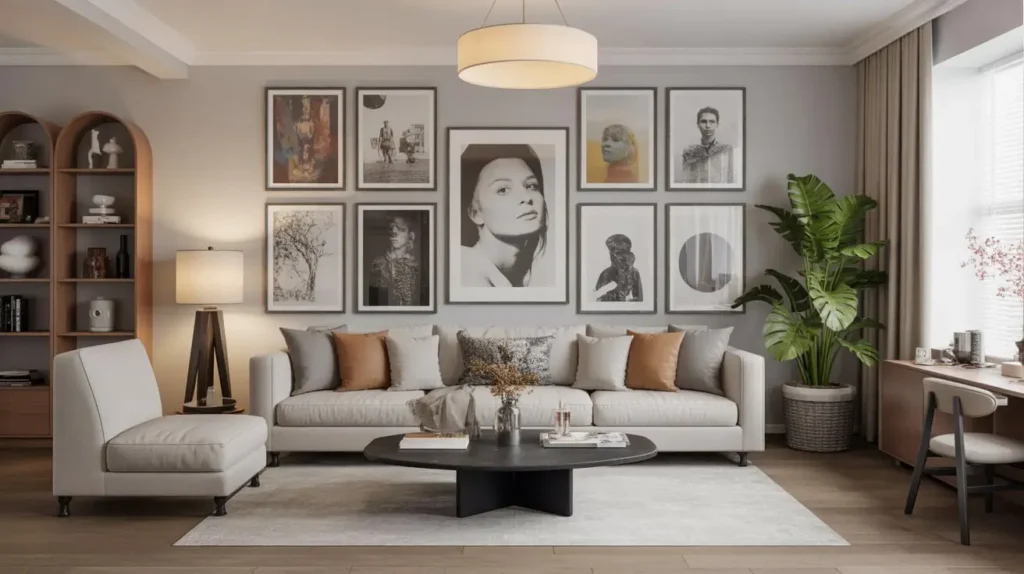
Sometimes your living room’s main attraction isn’t the furniture—it’s the art. Gallery walls transform blank spaces into curated exhibitions that showcase your personality and style.
Start by choosing your wall—typically the one your seating faces or a large blank wall that’s begging for attention. Measure it out and plan your layout on the floor first (trust me on this; nail holes are forever, or at least annoying to fix).
Mix frame styles and sizes for visual interest, but keep some element cohesive—maybe all black frames, or all gold, or all wood. Too much variation looks chaotic, not curated. The art itself can vary wildly in style, color, and subject matter as long as the frames create unity.
Include different types of art: photographs, prints, paintings, maybe even textiles or small sculptural pieces. Vary the sizes, but balance the visual weight across the wall so one side doesn’t feel way heavier than the other.
Space pieces 2-3 inches apart for that gallery feel. Too close feels cluttered; too far apart feels disconnected. Hang the center of the gallery at eye level (roughly 57-60 inches from the floor), and build out from there.
Here’s the fun part: change it up over time. Gallery walls aren’t set in stone. Swap pieces, add new finds, remove what doesn’t speak to you anymore. Your wall becomes a living, evolving collection that grows with you.
Make sure your lighting highlights the art—picture lights, track lighting, or even well-placed accent lamps. What’s the point of a gorgeous gallery wall if it’s sitting in shadow?
Soft Pastel Harmony
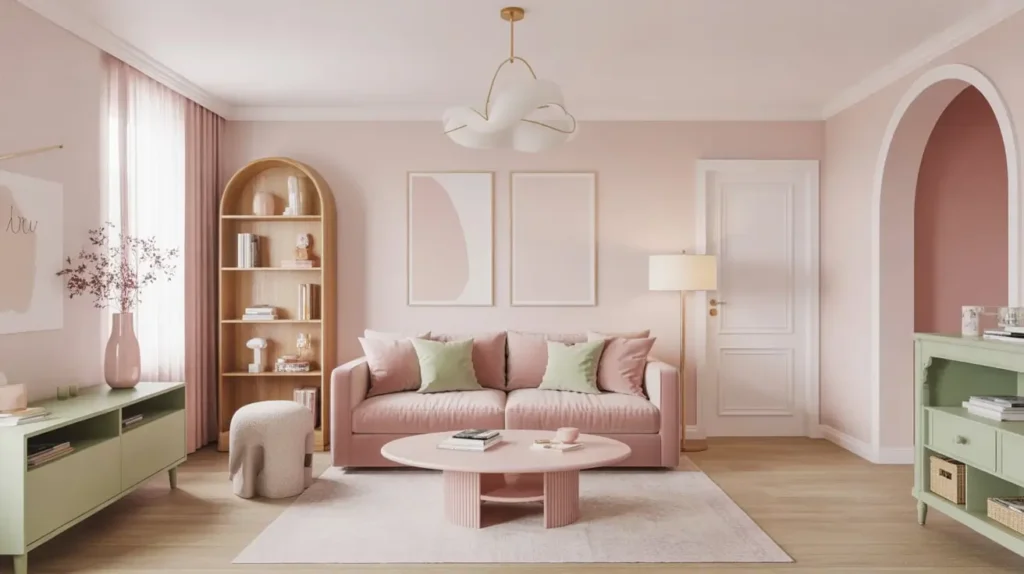
If you’re someone who finds joy in soft, gentle colors, pastel harmony might be your living room soulmate. This isn’t baby nursery pastels—we’re talking sophisticated, grown-up soft hues that create peaceful, uplifting spaces.
Build your palette around two or three pastel shades: maybe blush pink, sage green, and soft lavender. Or dusty blue, pale peach, and mint. The key is keeping the saturation low so colors complement rather than compete.
Use your largest pieces in neutral tones—white, cream, or light gray sofas and walls. Layer in pastels through accent pieces: pillows, throws, curtains, artwork, smaller furniture pieces. This approach keeps the space from feeling too sweet or overwhelming.
Texture and pattern prevent pastel spaces from looking washed out. Mix smooth velvets with nubby linens, add subtle patterns in your textiles, incorporate different materials. The variety keeps things interesting despite the soft color story.
Metallic accents work beautifully here—rose gold, brushed brass, or silver add shimmer and sophistication. They elevate pastels from cute to elegant, especially in light fixtures and decor accessories.
Keep the overall feel light and airy. Pastels naturally lend themselves to bright, open spaces with plenty of natural light. Sheer curtains, reflective surfaces, and strategic mirrors enhance the ethereal quality.
This style creates a calming, optimistic atmosphere that feels fresh and modern. It’s perfect if you want your living room to be a cheerful retreat from the world’s chaos—a soft place to land, literally and figuratively.
Timeless Monochrome Elegance
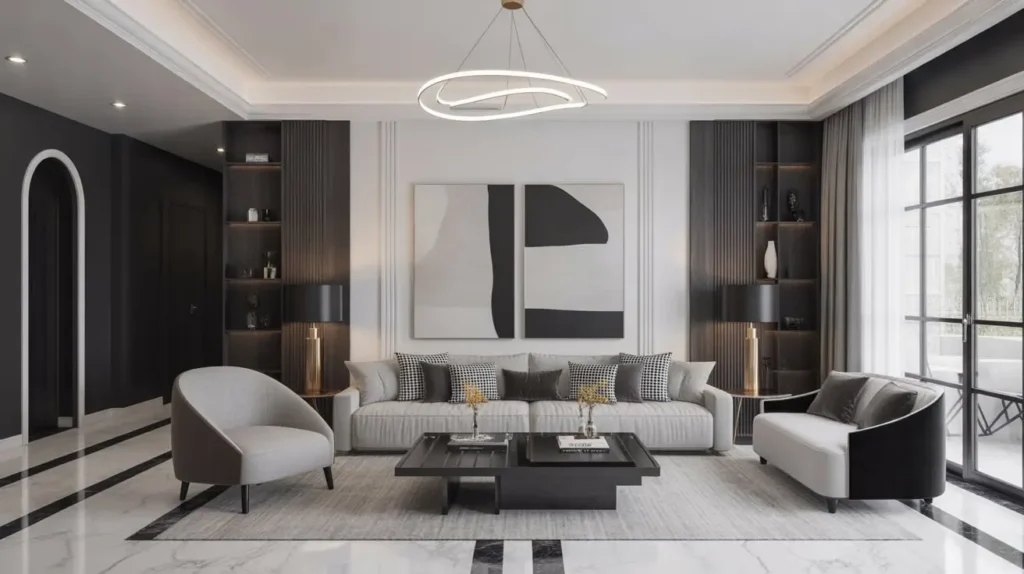
Let’s end with a classic that never goes out of style: monochrome elegance. Black, white, and every shade of gray in between create sophisticated spaces with staying power.
The beauty of monochrome lies in its simplicity and versatility. You’re working with one color family, which automatically creates cohesion. The challenge—and the fun—is making it interesting through variation, texture, and contrast.
Start with your black-to-white ratio. Mostly white with black accents feels bright and airy. Mostly black with white accents feels dramatic and cozy. An even split creates bold contrast. Decide your vibe and commit to a ratio that serves it.
Layer different shades of gray throughout the space. Charcoal, slate, dove, pearl—there are dozens of grays, each bringing different energy. This variation prevents the space from feeling flat or one-dimensional.
Texture saves monochrome from boring. Mix smooth with rough, shiny with matte, soft with hard: leather against linen, glossy lacquer against raw wood, polished marble against wool. The play of light across varied textures creates visual interest that color would normally provide.
Patterns add energy without disrupting the color scheme: geometric prints, stripes, abstract designs, even florals—all work as long as they stick to your monochrome palette. They create focal points and guide the eye around the room.
This style offers incredible flexibility for personality. Minimalists can keep it sparse and zen. Maximalists can layer patterns and textures to their heart’s content. The unifying color scheme holds everything together regardless of your design personality.
Plus, decorating becomes easier when you’re shopping within a limited color palette. Will this work in my living room? If it’s black, white, or gray, probably yes. The guardrails actually enhance creativity instead of limiting it.
Final Thoughts
Here’s the thing about cozy living rooms: they’re not about following rules or copying Pinterest boards exactly. They’re about creating spaces that feel like home to you—places where you want to spend time, where friends linger longer than planned, where life actually happens.
Maybe you’re drawn to the collected, layered feel of modern boho. Maybe you crave the breathing room of minimalist neutrals or the peaceful simplicity of Japandi. Perhaps you want to go bold with dark moody walls or bright color pops. The point isn’t picking the “right” style—it’s choosing what makes you feel warm, comfortable, and genuinely happy when you walk through the door.
Take what resonates from these ideas and make them your own. Mix styles if that’s your jam. Follow one aesthetic religiously if that brings you joy. There’s no design police coming to arrest you for combining farmhouse wood with industrial metal or adding color pops to your Scandinavian neutrals.
Your living room should tell your story, not someone else’s. So grab that throw pillow that makes you smile, arrange your furniture in ways that work for your actual life, and create a space that wraps around you like the warm ambiance you deserve.



